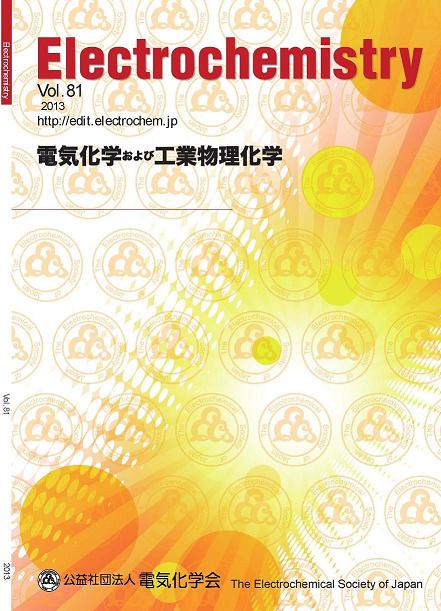All issues

Predecessor
Volume 81, Issue 8
Displaying 1-14 of 14 articles from this issue
- |<
- <
- 1
- >
- >|
Preface
-
Ryoji KANNO2013 Volume 81 Issue 8 Pages 615
Published: August 05, 2013
Released on J-STAGE: August 05, 2013
JOURNAL FREE ACCESSDownload PDF (428K)
Article
-
Tatyana KONKOVA, Yiqing KE, Sergey MIRONOV, Jin ONUKI2013 Volume 81 Issue 8 Pages 616-622
Published: August 05, 2013
Released on J-STAGE: August 05, 2013
JOURNAL FREE ACCESSThe high-resolution electron backscatter diffraction (EBSD) technique was applied to study microstructure and texture changes in the overburden layer as well as in upper and bottom parts of nano-scale damascene copper lines during annealing in a temperature range of 200–500°C. The microstructure in overburden layer was found to coarsen significantly at 200°C. At higher temperatures, however, it was established that the overburden layer and both parts of the lines were surprisingly stable. It was also shown that the microstructure in all studied regions was stabilized after achieving the same level of total grain-boundary area per unit volume. This observation has been interpreted as indirect evidence that grain growth behavior in the lines was governed by the pinning effect of second-phase particles entrapped during the electrodeposition process.View full abstractDownload PDF (6329K)
Technological Reports
-
Saya MATSUISHI, Noriyuki KITAORI, Norihiko OHNISHI2013 Volume 81 Issue 8 Pages 623-626
Published: August 05, 2013
Released on J-STAGE: August 05, 2013
JOURNAL FREE ACCESSStainless steel is preventive enough against rust, and is widely put to practical use because of the excellence in its material in aspects of sanitation. Junctions of the material change their color owing to high temperature in carrying out joining work by arc-welding. By performing the analysis of the portions where colors are changed and its execution together with high temperature accompanied with weldment, iron is isolated to be changed in its color. Based upon these results, a reagent with both higher safety and higher removal rate than conventional chemicals allowing change of color to be removed has been developed.View full abstractDownload PDF (1909K) -
Noriyuki KITAORI, Mayuko YOSHIOKA, Kota SEKIDO, Norihiko OHNISHI, Nano ...2013 Volume 81 Issue 8 Pages 627-633
Published: August 05, 2013
Released on J-STAGE: August 05, 2013
JOURNAL FREE ACCESSTwo kinds of small-sized electrolyzed water generator to be driven with a dry cell were investigated for sterilization in homes. These generation devices were able to produce the electrolyzed water which was weak acidic electrolyzed water or ozonated water. The weak acidic electrolyzed water was manufactured with the electrolysis of mixed solution of sodium chloride and citric acid, and ozonated water was formed by SPE (Solid Polymer Electrolyte) electrolysis of pure water. In this paper, it was reported about ability of weak acidic electrolyzed water and ozonated water for generation, sterilizing property and safety as performance of generator.View full abstractDownload PDF (1846K)
Topic
-
Takayuki ABE2013 Volume 81 Issue 8 Pages 634
Published: August 05, 2013
Released on J-STAGE: August 05, 2013
JOURNAL FREE ACCESSDownload PDF (198K) -
Susumu KUWABATA, Tsukasa TORIMOTO2013 Volume 81 Issue 8 Pages 635-640
Published: August 05, 2013
Released on J-STAGE: August 05, 2013
JOURNAL FREE ACCESSDownload PDF (4864K) -
Hideo DAIMON, Minoru INABA2013 Volume 81 Issue 8 Pages 641-645
Published: August 05, 2013
Released on J-STAGE: August 05, 2013
JOURNAL FREE ACCESSDownload PDF (3200K) -
Hiroshi SHIIGI, Tsutomu NAGAOKA2013 Volume 81 Issue 8 Pages 646-649
Published: August 05, 2013
Released on J-STAGE: August 05, 2013
JOURNAL FREE ACCESSDownload PDF (2402K) -
Junji NAKAMURA2013 Volume 81 Issue 8 Pages 650-654
Published: August 05, 2013
Released on J-STAGE: August 05, 2013
JOURNAL FREE ACCESSDownload PDF (1930K)
-
Takeyoshi OKAJIMA2013 Volume 81 Issue 8 Pages 655-658
Published: August 05, 2013
Released on J-STAGE: August 05, 2013
JOURNAL FREE ACCESSDownload PDF (1341K)
Salon
-
Yasuko YANAGIDA2013 Volume 81 Issue 8 Pages 659-660
Published: August 05, 2013
Released on J-STAGE: August 05, 2013
JOURNAL FREE ACCESSDownload PDF (1106K) -
Seiya TSUJIMURA2013 Volume 81 Issue 8 Pages 661-662
Published: August 05, 2013
Released on J-STAGE: August 05, 2013
JOURNAL FREE ACCESSDownload PDF (1671K)
-
2013 Volume 81 Issue 8 Pages 663-670
Published: August 05, 2013
Released on J-STAGE: August 05, 2013
JOURNAL FREE ACCESSDownload PDF (953K) -
2013 Volume 81 Issue 8 Pages 672
Published: August 05, 2013
Released on J-STAGE: December 27, 2023
JOURNAL FREE ACCESSDownload PDF (434K)
- |<
- <
- 1
- >
- >|